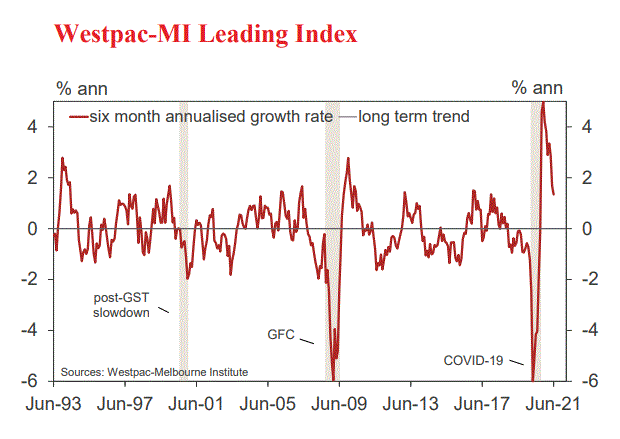Westpac with the note:

The growth rate in the Leading Index peaked at 5% back in November last year shortly after 22 consecutive negative prints and a particularly large -6% during last year’s national COVID lock-down. It has since fallen back to 1.34%, still comfortably above zero and therefore signalling the outlook for above trend growth.
On July 20 Westpac revised its near-term growth forecasts to take account of the lock-downs in both NSW and Victoria. We now expect that the NSW economy will contract by 3.1% in the September quarter and the Victorian economy will contract by 0.1%.
That assumes the NSW lockdown will last a total of eight weeks and the Victorian lockdown three weeks. Contractions in the two biggest states will mean that the national economy is likely to contract by 0.7% in the September quarter.
We expect the economy to bounce back once measures bring outbreaks under control, with the December quarter expected to show a 2.5% rebound nationally. Further disruptions should become more limited as border controls tighten and vaccination rates surge – the latter likely to get a big boost once adequate supplies of Pfizer and Moderna arrive from August on and as vaccination hesitancy/complacency tumbles.
That would see Australia’s growth rate down from our previous estimate of 4.8% to 4.4% – still comfortably above trend.
Those forecasts are based on there being no extended lockdowns similar to the current Sydney lockdown in the December quarter. As Australia moves rapidly to a globally competitive vaccination rate through the first quarter of 2022 lockdowns can be expected to be much less frequent.
Growth can be expected to remain above trend through 2022.
That robust underlying momentum is clear in the latest Leading Index read. Over the last six months growth in the Leading Index has slowed from an extremely strong 4.20% to a more subdued, but still strong, 1.34% pace.
Six of the eight components have contributed to the 2.9ppt slowdown with the biggest shifts coming from: US industrial production (contributing –1.2ppts); total hours worked (–0.7ppts); the Westpac-MI Consumer Expectations Index (–0.5ppts); with the Westpac-MI Unemployment Expectations Index and dwelling approvals each shaving another 0.3ppts of the growth pace.
Recent lockdown measures have had some impact – Victoria’s 14-day lockdown in June impacted total hours worked, and both this and the NSW lockdown hit consumer sentiment-based measures through both June and July. However, the full hit has yet to show through with the impact from the further tightening in restrictions in NSW, the return to another extended lockdown in Victoria, and additional measures in other states set for coming months.
While the slowing in momentum has been broadly based, commodity prices have provided some offset. Prices have posted a remarkable 27% surge in AUD terms since the start of the year, building on a robust 22% gain over the second half of 2020. The surge has seen this component add another 0.2ppts to the index growth rate since the start of the year.
Rising commodity prices now account for just over a third of the 1.34% growth in the headline index.
The Reserve Bank Board next meets on August 3. We expect the Board will be advised of significant downward revisions for growth in the September quarter, possibly in line with our own views that there will be a contraction.
In the near term, with the cash rate at its effective low of 0.1% policy flexibility is only available through the Bank’s bond purchase program. The Minutes of the Board’s July meeting noted: “Given the high degree of uncertainty about the economic outlook, members agreed that there should be flexibility to increase or reduce weekly bond purchases in the future, as warranted by the state of the economy at the time.”
The August Board meeting would be an appropriate time to use that flexibility. At the least it could announce that the taper in purchases from $5 billion to $4 billion which was planned for early September will be deferred.
A better approach, in keeping with the need to be seen to be supporting the economy at a difficult time, would be to announce a review of the program at or before the September meeting where the current purchase rate of $5 billion per week could be lifted to $6 billion rather than reduced to $4 billion.
Indeed, a decision to immediately lift purchases to $6 billion per week would certainly send the right signal that the Bank is responsive to economic developments and is prepared to use its new flexible policy tool accordingly.

